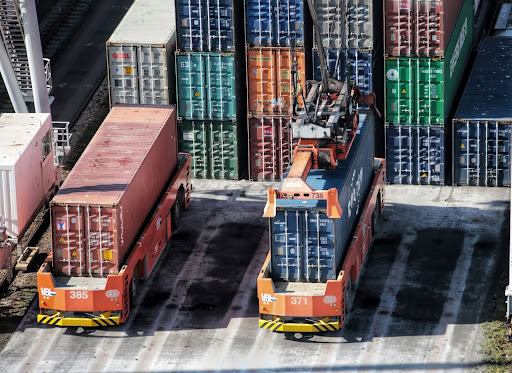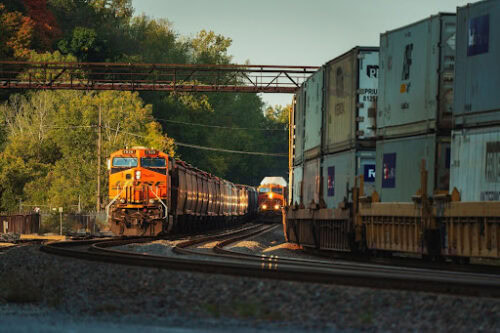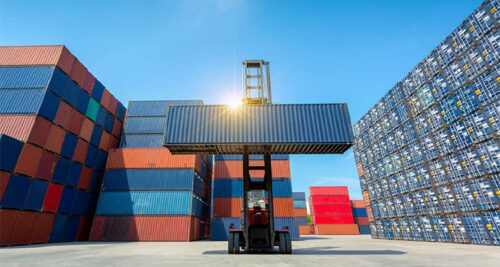Drayage vs Intermodal: Explaining Two Connected Transportation Modes

Efficient logistics rely on different modes of transportation to move freight smoothly from one point to another. Two crucial methods are drayage and intermodal transportation, each serving distinct roles in the supply chain. Both methods handle goods efficiently but differ in scope and purpose.
Drayage focuses on short-distance transport, often between transportation hubs like rail ramps and distribution centers. Intermodal freight transport, on the other hand, integrates multiple modes, such as rail and trucking, and is ideal for long distances.
In this blog, learn how drayage vs intermodal compares, connects, and optimizes modern business logistics.
What is Intermodal?
Intermodal transportation uses multiple modes of transport, like rail and truck, to move freight without directly handling the intermodal containers. It combines rail terminals, trucking, and sometimes shipping containers, streamlining the shipping process and reducing costs.
Businesses benefit from their ability to cover long distances efficiently. Global trade depends on intermodal freight, which integrates different transport modes. It supports modern logistics with reduced fuel surcharges and faster cargo movement to the final destination.
What is Drayage?
Drayage refers to short-distance cargo transportation between hubs, such as ports, rail yards, or distribution centers. It bridges gaps between long-haul systems and local delivery, ensuring efficient movement.
Typically managed by drayage carriers, it connects shipping containers to intermodal terminals, enabling smooth drayage operations. Drayage plays a critical role in the supply chain, especially for the final legs of freight delivery in urban and regional areas.
Drayage Classification
Drayage services are categorized based on the type of freight, distance covered, and delivery requirements. Each type plays a critical role in facilitating the efficient movement of goods in modern logistics.
Here are the main classifications:
- Pier Drayage: Moves cargo from ports to rail terminals or distribution centers. This service is ideal for shipping containers and supports short distances and is essential for international freight.
- Intermodal Drayage: Connects freight trains with intermodal trucking, enabling seamless transportation. This service integrates rail and truck, ensuring cargo reaches final destinations.
- Shuttle Drayage: Transfers freight within local areas, like rail yards or between nearby transportation hubs. This reduces congestion and speeds up short-distance transport.
- Expedited Drayage: Handles urgent cargo, offering faster delivery for critical shipments. Often used by drayage specialists, this service minimizes delays in the shipping process.
- Intra-Carrier Drayage: Moves goods between facilities of the same drayage carrier, ensuring smooth transitions during intermodal moves. This enhances coordination and lowers drayage costs.
Connection between Drayage and Intermodal
Drayage and intermodal transportation work together to create a seamless supply chain, facilitating smooth movement of goods across different transport modes, enhancing efficiency, and bridging gaps between local delivery and long-distance networks.

Drayage handles short-distance transportation, connecting rail yards, ports, and distribution centers. Intermodal integrates multiple systems, such as rail and trucking, managing long-haul trucking over long distances.
For example, intermodal drayage often bridges freight trains with trucking, ensuring shipping containers reach their final destination. This partnership optimizes modern logistics and enhances the shipping process.
Drayage vs Intermodal
Drayage and intermodal transportation serve unique roles but are tightly connected within logistics. Understanding their differences helps optimize cargo movement.
Here’s a detailed comparison:
- Scope: Drayage focuses on shorter distances within local areas, efficiently connecting distribution centers and rail yards. Intermodal manages long-haul routes, utilizing multiple modes of transport, such as trucks, freight trains, and container ships.
- Distance: Drayage covers short distances, such as moving shipping containers between local hubs and rail terminals. Intermodal spans longer distances, supporting international shipping processes and reducing costs through integrated transportation systems.
- Mode of Transport: Drayage relies on trucks for flexibility in short-distance transport. Intermodal combines trucking, rail, and container ships, ensuring smooth intermodal moves for both domestic and global freight operations.
- Purpose: Drayage links transportation hubs for localized cargo movement within supply chains. Intermodal focuses on delivering freight efficiently and cost-effectively across longer distances, utilizing optimized, multimodal transportation networks.
- Function: Drayage handles the final legs of freight transport, bridging gaps in short distances. Intermodal integrates different modes to streamline the process of moving freight seamlessly across extended logistics networks.
- Equipment: Drayage uses specialized trucks designed for shipping containers and rapid loading. Intermodal employs freight trains, railroads, and container ships, ensuring compatibility across global logistics systems.
- Infrastructure: Drayage depends on local distribution centers, rail yards, and drayage carriers for localized operations. Intermodal utilizes advanced intermodal terminals and globally integrated networks for large-scale, streamlined cargo movement.
- Environmental Impact: Drayage often results in higher emissions due to reliance on trucks. Intermodal reduces carbon footprints by shifting long-haul freight to rail, offering an eco-friendly solution for modern transportation systems.
- Safety: Drayage prioritizes safety in urban environments, especially near ports and rail yards. Intermodal minimize risks through secure freight train systems, enhancing safety in both domestic and international logistics chains.
- Flexibility: Drayage adapts to urgent schedule changes, making it ideal for time-sensitive operations. Intermodal emphasizes efficient, standardized processes, ensuring timely and reliable movement of goods across diverse transport modes.
Benefits of Intermodal
Intermodal transportation offers significant advantages in modern logistics. Combining multiple modes of transport enhances efficiency and reduces shippers’ costs.
Here are its key benefits:
- Reduced Transportation Costs: Intermodal combines rail and trucking, reducing fuel costs and leveraging freight trains for long haul distances. This efficient model lowers expenses compared to relying on just one mode.
- Improved Security: Using sealed shipping containers in intermodal freight minimizes cargo tampering during intermodal moves, ensuring safer delivery to distribution centers and beyond.
- Lower Emissions: Shifting goods from trucks to rail reduces environmental impact. Intermodal shipping also significantly lowers emissions, making it an eco-friendly option for long-distance transportation.
- Greater Efficiency: Seamless transfer at rail yards and intermodal terminals reduces delays. Combining trucking and rail enhances speed and reliability, ensuring goods are delivered promptly to shippers and meet tight schedules.

Benefits of Drayage
Drayage plays a vital role in bridging short-distance transportation gaps. It ensures timely cargo delivery between distribution centers, ports, and rail yards.
Key benefits include:
- Faster Cargo Movement: Drayage simplifies moving goods between local hubs, such as a rail yard and distribution center, ensuring timely and efficient transfers for shipments requiring urgent delivery within short distances.
- Flexibility in Urgent Shipments: Drayage services adapt to changing schedules to handle last-minute delivery needs. Drayage trucking ensures efficient transport in dynamic logistical setups.
- Effective Use in Congested Areas: Designed for short distances, drayage operates well in crowded ports and urban areas. Drayage carriers navigate tight schedules and ensure reliable service.
- Cost-Effective for Local Deliveries: Drayage minimizes transportation costs for short distances. It optimizes local logistics by using efficient routes and reducing unnecessary expenses for nearby freight transfers.
How to Choose Between Intermodal and Drayage
Choosing between drayage vs intermodal depends on your logistical needs. Consider the nature of the cargo, distance, and budget. Drayage services excel in short distances and localized transport, while intermodal moves manage longer distances with multiple transport modes like freight trains and trucks.
Start by assessing whether your cargo involves transporting goods over a critical link in the supply chain or simply requires efficient cross-dock transfers at intermodal terminals. Factor in costs, time, and infrastructure to ensure optimal delivery.
Conclusion
Understanding drayage vs intermodal helps businesses optimize their logistics strategies. Drayage trucking supports short-distance transport, ensuring shipping containers reach freight trains or intermodal terminals efficiently. It connects critical links within local supply chains.
Conversely, intermodal shipping handles longer distances, using trucks, freight trains, and container ships for seamless intermodal moves.
Each method plays a unique role in moving goods effectively. Selecting between them depends on cargo type, distance, and logistical needs. They create an efficient, cost-effective network for modern drayage carriers and shippers.
